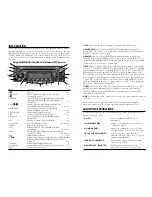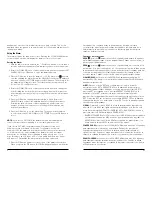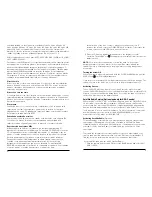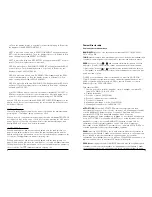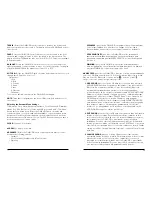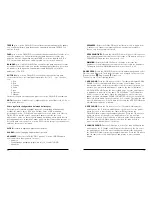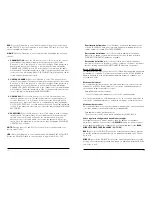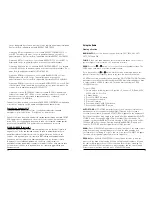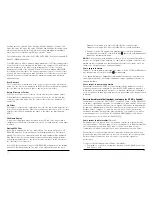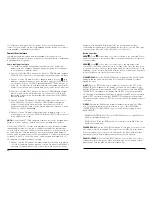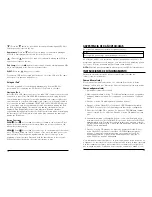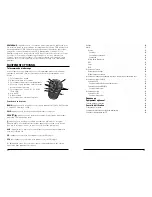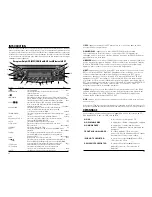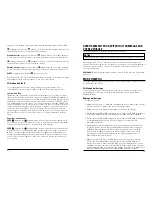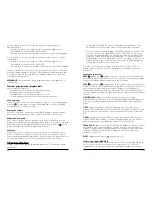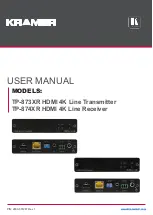
17
fixed-bit rates: 32 kpbs, 40 kpbs, 64 kpbs, 80 kpbs, 96 kpbs, 112 kpbs, 128
kpbs, 160 kpbs, 192 kpbs, 224 kpbs, 256 kpbs, and 320 kpbs. Both single and
multi-session discs will play. Song title, artist name and album are available
when discs are recorded using ID3 tags, versions 1 and 2.
Files supported on USB sticks: MP1, MP2, MP3 (VBR) , WMA (ver 9 and VBR)
and ACC (MPEG4 and M4A).
Your MP3 player is able to read and play a maximum of 50 folders and playlists.
Long files, folders or a combination can reduce the number of files and folders
that can be played. If you want to play a large number of files or folders,
minimize the length of the files and folders. You can also play an MP3/WMA
recorded without file folders. The system can support up to 11 levels of folder
nesting. If a disc contains more than 50 folders or 11 folder levels, your player
will only let you access and navigate the maximum number and will ignore
additional items.
Root Directory
The root directory is treated as a folder. If the root directory has compressed
audio files, the directory is displayed as ROOT. All files contained directly under
the root directory are accessed prior to any root directory folders.
Empty Directory or Folder
If there is a root directory or folder in the file structure that contains empty
folders/subfolders, play advances to the next folder in the file structure that
contains compressed audio files. The empty folder will not be displayed or
numbered.
No Folder
When a disc contains only compressed files, the files are located under the root
folder. The next and previous folder functions have no function on a CD recorded
without folders. When displaying the name of the folder, the radio displays
ROOT.
File Name Display
A song title is displayed when contained in the ID3 tag. Titles longer than 8
characters scroll at a rate of 8 characters every 2 seconds until the entire name
is shown.
Playing MP3 Files
Insert a disc partway into the slot, label-side up. The player will pull it in, CD
READING and the CD icon will appear on the display and the CD will begin
playing. The type of file, elapsed time and the track number will be displayed.
Play begins from the first track and continues sequentially through all tracks.
After playing the last track of the last folder, play continues at the first track of
the first folder or root directory.
Insert a USB stick fully into the slot. USB READING will appear on the display,
and the USB will begin playing. The type of file, elapsed time and the track
50
Para subir el volumen, gire el botón ON/AUDIO en sentido horario.
Para bajar el volumen, gire el botón ON/AUDIO en sentido antihorario.
8. Presione el botón OK nuevamente para finalizar y regresar la pantalla al
funcionamiento normal. El ícono de ALARM aparecerá en la pantalla para
indicar que la alarma está activa.
NOTA:
Si no presiona ni gira ningún botón dentro de los 8 segundos durante el
proceso de configuración de la alarma, se cancelará la configuración del reloj de
alarma y la radio regresará a su funcionamiento normal, conservando todos los
cambios de configuración que se hayan realizado.
Cómo apagar la alarma
Cuando se activa la alarma, mantenga presionado el botón CLOCK/ALARM hasta
que desaparezca el ícono de ALARM de la pantalla.
Si no apaga la alarma, se apagará automáticamente después de 63 minutos. La
radio regresará al modo (encendido o apagado) en que estaba antes de que se
apagara la alarma.
Cómo activar la repetición de alarma
Para utilizar la función SNOOZE, presione cualquier botón durante menos de 2
segundos cuando suene la alarma. Se mostrará SNOOZE durante 3 segundos y
la alarma se postergará durante 9 minutos. Si presiona cualquier botón durante
estos 3 segundos, la radio regresará al modo en que estaba antes de que sonara
la alarma.
Servicio de radio satelital (opcional y sólo para los EE. UU. y Canadá)
Cuando aparece el logotipo XM
®
, SIRIUS
®
o radio SAT sobre el botón ON/AUDIO
de su radio, significa que su equipo es compatible con radio satelital. XM y Sirius
son servicios de radio satelital que ofrecen más de 100 canales de programación
de audio de calidad digital y se pueden escuchar sin interrupciones por todos los
Estados Unidos contiguos. Se requiere un costo por el servicio para recibir
emisiones satelitales. Para obtener más información, comuníquese con XM en
www.xmradio.com o por teléfono al 1-800-852-XMXM (9696) o con Sirius en
www.sirius.com o por teléfono al 1-888-539-7474.
Cómo activar la radio satelital
(Opcional)
Para aprovechar esta función, debe comprar una suscripción mensual de radio
satelital. Si aparece XM en su radio, ésta es compatible con la Radio satelital XM
y necesitará una suscripción a XM. Si aparece Sirius en su radio, ésta es
compatible con la Radio satelital Sirius y necesitará una suscripción a Sirius.
Para activar el receptor satelital externo o integrado, debe proporcionarle a su
proveedor de radio satelital el número de serie electrónico del receptor satelital.
Para encontrar el número de serie electrónico, complete las siguientes
instrucciones.
Si su proveedor de radio satelital es Radio satelital XM:
1. Con la radio y el contacto encendidos, presione el botón BAND y seleccione
XM1, XM2 or XM3.

